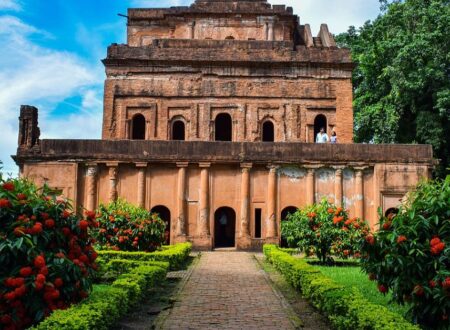The Ratneshwar Temple is one of the most famous Indian Temples located at Dattatreya Ghat. It has a history of almost 300 years. According to the locals, no devotees worship here, and no water is offered to Lord Shiva. Residents of the area claim that if worship is performed at the temple, evil begins to manifest in the home.

As a result of the tremendous weight of the ghat’s construction, Ratneshwar temple is half immersed in the river. Several of Kashi’s most important shrines are concealed behind the labyrinthine maze of alleyways. Which is located above the ghat (the field of fulfillment). The Lord Of All Heroes, Vireshvara, was said to have been born here.
History
Amongst the popular legends, the most interesting one is the story of how it was built. There are many different stories told about the construction of this temple, here is the most common one told. At the time when Rani Ahilya Bai was constructing temples and ponds in Holkar city, at the same time the queen’s maid Ratna Bai also expressed her desire to build a Shiva temple near Manikarnika Kund, for which she asked Ahilya Bai. She then borrowed some money from the queen and got the beautiful temple built.

Ahilya Bai was very pleased to see this, but she asked the maid Ratna Bai not to give her own name to this temple. But the Ratna bai decided to name this temple ‘Ratneshwar Mahadev’ after her own name. On this Ahilya Bai got angry and cursed that no one will be able to worship in this temple.
This is the lore behind the temple. But, it is also said that between the 15th and 16th centuries many kings and queens came to live in Kashi. During their stay in Kashi, they got many Havelis, kothis, and temples built in Varanasi. One of these kings’ mothers used to live here with one of her most trusted servants. At Sindhia Ghat, the servant called many craftsmen of the country including a talented craftsman from Rajasthan, and started building a temple of Mahadev in the name of the king’s mother.
Significance
He went there with his mother once the temple was completed and said that ‘the obligation of your milk’ had been paid up. The mother began leaving after bowing to Mahadev, who was sitting inside the temple from the outside. Walk into the temple and take darshan, according to the son. The mother then told the son to turn around and look at the temple because heit had sunk into the ground on one side. It is said that this temple has been slanted on one side like way since then. According to legend, the servant’s mother’s name was Ratna, hence the temple was named Ratneshwar Mahadev.

The world-famous Leaning Tower of Pisa, also known as the Torre Pendente di Pisa, was erected in 1173. The ground under one side began to collapse under the weight of the stones soon after it was completed. According to the most recent report, the tower now leans at 3.99 degrees due to substantial effort done to straighten it. As a result, the Leaning Tower of Pisa does lean about 4 degrees, which is less than Ratneshwar Temple, which leans more than 9 degrees. When the water level drops in the summer, the entrance to the garbagriha becomes apparent, and some people come to see it.
Conclusion
The ancient Ratneshwar temple in Uttar Pradesh is the only temple in India that has been tilted to one side for almost 300 years. This temple has been compared to the leaning tower of Pisa. Another fascinating characteristic of this temple is that it is periodically submerged in water for six months. During floods, water reaches the temple’s pinnacle, which is more than 40 feet high. After the flood, sand is piled inside the shrine. No one knows the secret of how the temple stands today, despite its slanted ness.






